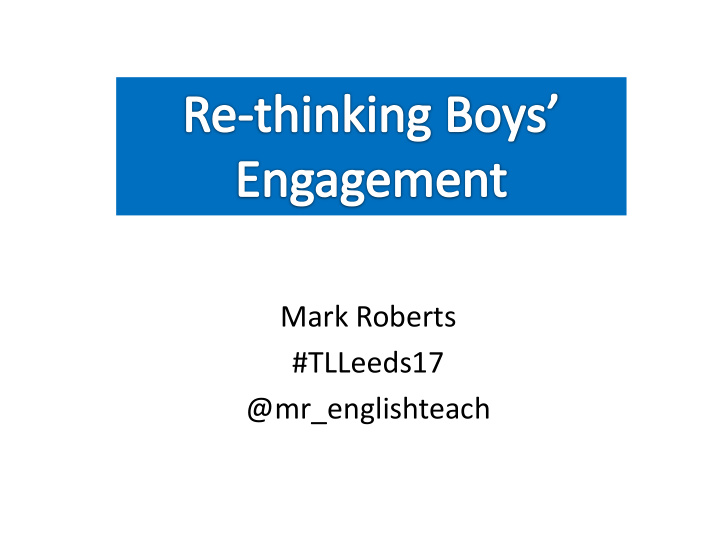



Mark Roberts #TLLeeds17 @mr_englishteach
1. Boys like competition • Demotivates boys who don’t immediately succeed • Boys who don’t succeed are the ones who need most motivation Jackson (2002; 2006) Elkjaer (1992)
PEA World Cup
2. Boys and girls are ‘naturally different’ and need to be taught differently • Differences between the ‘male brain’ and ‘female brain’ are slight and contentious • More within gender differences than between gender differences Baron-Cohen (2004), Slavin (1994)
Mentions of gender? • boys do better on standardized tests, girls earn better classroom grades • distributions of boys’ and girls’ performance on either one is largely overlapping • addressing it is not likely to make either group learn more in school
3. Boys need topics that are relevant to them • ‘Boy-friendly’ curricula do not improve boys’ achievement • Gender-stereotyping ignores pupils’ genuine interests and limit aspirations of boys (and girls) Pickering (1997), Lingard et al (2002; 2003), Keddie and Mills (2008), Younger and Warrington at al (2005)
A few more stubbornly common myths… 4. Boys have different learning styles 5. Boys prefer male teachers 6. All boys are struggling
Key questions 1. How had I managed to get such good results while following these strategies? 2. How come I’d managed to get good results out of really difficult boys?
despite not because
NPQSL – risk factors • Boys • FSM • L4OE • Placed in bottom sets • Poor attendance
Headline figures • 12 of 15 pupils gained C or above in English, 10 in maths • 9 pupils got C or above in both • 8% A*-C rise in English • 7% A*-C rise in maths • 12% rise in Basics measure • FSM gap narrowed by 17% in maths, 15% in English
What we didn’t do: • Intervention • Peer coaching • Academic mentoring • Pastoral support • Rewards • Incentives • Increased parental engagement • Notify the pupils
So what really works?
A. Quality feedback that encouraged lots of repetitive practice • ‘live’ or ‘short’ marking • Onus on motivation of immediate improvement Hattie and Timperley (2007)
B. Positive relationships based on effective behaviour management Discussion time (3 minutes) • Which strategies do you think should be on my list? • Why?
My list • Depersonalise behaviour • Don’t hold grudges • Very clear expectations • Positive reinforcement • Let them know that you care (but not too much) • 80% pep talks/instilling a sense of belief • 20% letting them know when you’re disappointed • Stay calm at all times (apart from when you’re pretending to be really quite cross)
C. Really high expectations for all pupils • ‘tendency to associate boys with underachievement and girls with high achievement’ • ‘80% of the teachers expected that boys and girls should get same results. This commitment to equal achievement, however, was not reflected in teachers' perceptions…about classroom attitude and behaviour and ability within different areas of the curriculum.’ Jones and Myhill (2004) ‘Troublesome boys’ and ‘compliant girls’
• ‘Teachers give voice to a deficit model of male achievement. Boys are principally seen in terms of the things they cannot, will not and do not do. Girls are seen in terms of the things they have achieved and in terms of compliant behaviour.’
Discussion time (5 minutes) • What implications does this have for your classroom practice? • Do teachers in your school ‘give voice to a deficit model of male achievement’? • How do you know?
The top set effect • What happened when I decided to set on potential rather than current ability?
But couldn’t that apply to girls?
Your questions please
Recommend
More recommend